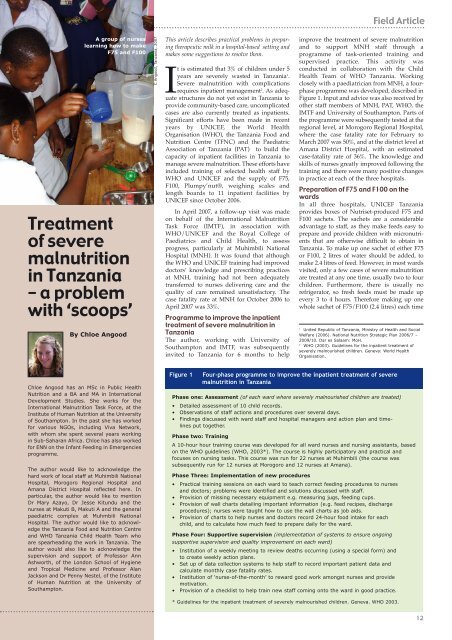Scoop situation - Field Exchange - Emergency Nutrition Network
Scoop situation - Field Exchange - Emergency Nutrition Network
Scoop situation - Field Exchange - Emergency Nutrition Network
- No tags were found...
Create successful ePaper yourself
Turn your PDF publications into a flip-book with our unique Google optimized e-Paper software.
<strong>Field</strong> ArticleA group of nurseslearning how to makeF75 and F100Treatmentof severemalnutritionin Tanzania– a problemwith ‘scoops’By Chloe AngoodC Angood, Tanzania, 2007This article describes practical problems in preparingtherapeutic milk in a hospital-based setting andmakes some suggestions to resolve them.It is estimated that 3% of children under 5years are severely wasted in Tanzania 1 .Severe malnutrition with complicationsrequires inpatient management 2 . As adequatestructures do not yet exist in Tanzania toprovide community-based care, uncomplicatedcases are also currently treated as inpatients.Significant efforts have been made in recentyears by UNICEF, the World HealthOrganisation (WHO), the Tanzania Food and<strong>Nutrition</strong> Centre (TFNC) and the PaediatricAssociation of Tanzania (PAT) to build thecapacity of inpatient facilities in Tanzania tomanage severe malnutrition. These efforts haveincluded training of selected health staff byWHO and UNICEF and the supply of F75,F100, Plumpy’nut®, weighing scales andlength boards to 11 inpatient facilities byUNICEF since October 2006.In April 2007, a follow-up visit was madeon behalf of the International MalnutritionTask Force (IMTF), in association withWHO/UNICEF and the Royal College ofPaediatrics and Child Health, to assessprogress, particularly at Muhimbili NationalHospital (MNH). It was found that althoughthe WHO and UNICEF training had improveddoctors’ knowledge and prescribing practicesat MNH, training had not been adequatelytransferred to nurses delivering care and thequality of care remained unsatisfactory. Thecase fatality rate at MNH for October 2006 toApril 2007 was 33%.Programme to improve the inpatienttreatment of severe malnutrition inTanzaniaThe author, working with University ofSouthampton and IMTF, was subsequentlyinvited to Tanzania for 6 months to helpimprove the treatment of severe malnutritionand to support MNH staff through aprogramme of task-oriented training andsupervised practice. This activity wasconducted in collaboration with the ChildHealth Team of WHO Tanzania. Workingclosely with a paediatrician from MNH, a fourphaseprogramme was developed, described inFigure 1. Input and advice was also received byother staff members of MNH, PAT, WHO, theIMTF and University of Southampton. Parts ofthe programme were subsequently tested at theregional level, at Morogoro Regional Hospital,where the case fatality rate for February toMarch 2007 was 50%, and at the district level atAmana District Hospital, with an estimatedcase-fatality rate of 36%. The knowledge andskills of nurses greatly improved following thetraining and there were many positive changesin practice at each of the three hospitals.Preparation of F75 and F100 on thewardsIn all three hospitals, UNICEF Tanzaniaprovides boxes of Nutriset-produced F75 andF100 sachets. The sachets are a considerableadvantage to staff, as they make feeds easy toprepare and provide children with micronutrientsthat are otherwise difficult to obtain inTanzania. To make up one sachet of either F75or F100, 2 litres of water should be added, tomake 2.4 litres of feed. However, in most wardsvisited, only a few cases of severe malnutritionare treated at any one time, usually two to fourchildren. Furthermore, there is usually norefrigerator, so fresh feeds must be made upevery 3 to 4 hours. Therefore making up onewhole sachet of F75/F100 (2.4 litres) each time1United Republic of Tanzania, Ministry of Health and SocialWelfare (2006). National <strong>Nutrition</strong> Strategic Plan 2006/7 –2009/10. Dar es Salaam: MoH.2WHO (2003). Guidelines for the inpatient treatment ofseverely malnourished children. Geneva: World HealthOrganisation.Chloe Angood has an MSc in Public Health<strong>Nutrition</strong> and a BA and MA in InternationalDevelopment Studies. She works for theInternational Malnutrition Task Force, at theInstitute of Human <strong>Nutrition</strong> at the Universityof Southampton. In the past she has workedfor various NGOs, including Viva <strong>Network</strong>,with whom she spent several years workingin Sub-Saharan Africa. Chloe has also workedfor ENN on the Infant Feeding in Emergenciesprogramme.The author would like to acknowledge thehard work of local staff at Muhimbili NationalHospital, Morogoro Regional Hospital andAmana District Hospital reflected here. Inparticular, the author would like to mentionDr Mary Azayo, Dr Jesse Kitundu and thenurses at Makuti B, Makuti A and the generalpaediatric complex at Muhmbili NationalHospital. The author would like to acknowledgethe Tanzania Food and <strong>Nutrition</strong> Centreand WHO Tanzania Child Health Team whoare spearheading the work in Tanzania. Theauthor would also like to acknowledge thesupervision and support of Professor AnnAshworth, of the London School of Hygieneand Tropical Medicine and Professor AlanJackson and Dr Penny Nestel, of the Instituteof Human <strong>Nutrition</strong> at the University ofSouthampton.Figure 1Four-phase programme to improve the inpatient treatment of severemalnutrition in TanzaniaPhase one: Assessment (of each ward where severely malnourished children are treated)• Detailed assessment of 10 child records.• Observations of staff actions and procedures over several days.• Findings discussed with ward staff and hospital managers and action plan and timelinesput together.Phase two: TrainingA 10-hour hour training course was developed for all ward nurses and nursing assistants, basedon the WHO guidelines (WHO, 2003*). The course is highly participatory and practical andfocuses on nursing tasks. This course was run for 22 nurses at Muhimbili (the course wassubsequently run for 12 nurses at Morogoro and 12 nurses at Amana).Phase Three: Implementation of new procedures• Practical training sessions on each ward to teach correct feeding procedures to nursesand doctors; problems were identified and solutions discussed with staff.• Provision of missing necessary equipment e.g. measuring jugs, feeding cups.• Provision of wall charts detailing important information (e.g. feed recipes, dischargeprocedures); nurses were taught how to use the wall charts as job aids.• Provision of charts to help nurses and doctors record 24-hour food intake for eachchild, and to calculate how much feed to prepare daily for the ward.Phase Four: Supportive supervision (implementation of systems to ensure ongoingsupportive supervision and quality improvement on each ward)• Institution of a weekly meeting to review deaths occurring (using a special form) andto create weekly action plans.• Set up of data collection systems to help staff to record important patient data andcalculate monthly case fatality rates.• Institution of ‘nurse-of-the-month’ to reward good work amongst nurses and providemotivation.• Provision of a checklist to help train new staff coming onto the ward in good practice.* Guidelines for the inpatient treatment of severely malnourished children. Geneva. WHO 2003.12
















